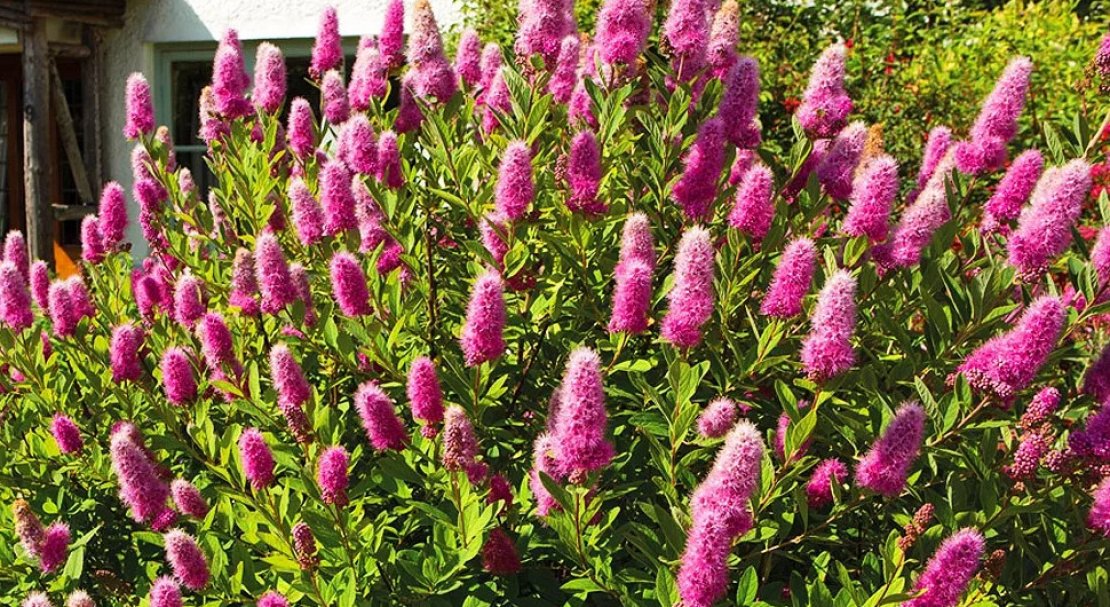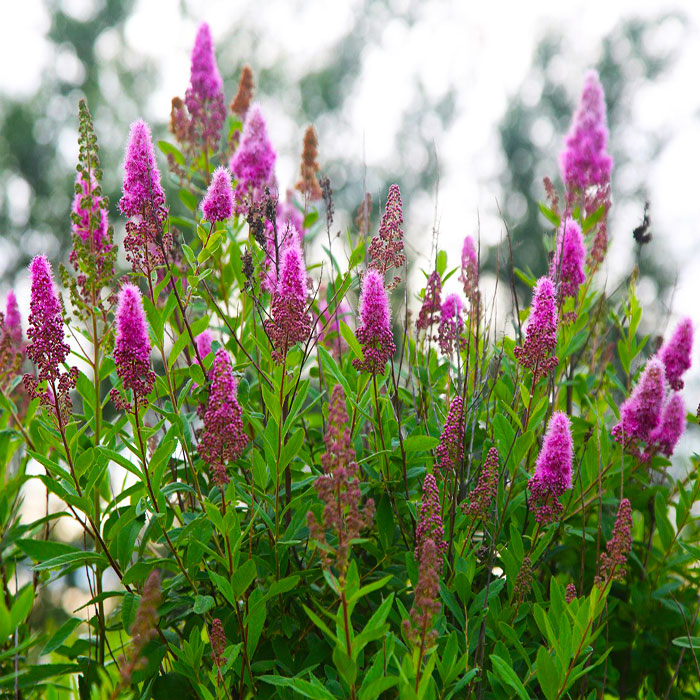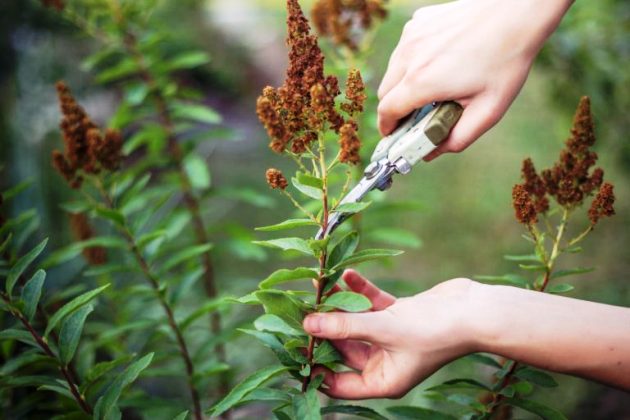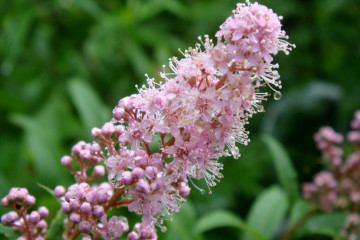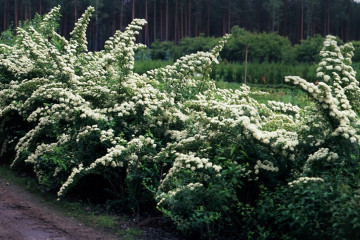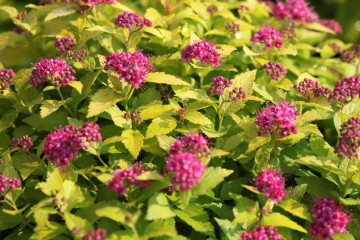Spirea Billard - description, planting and care
Content:
Billard's Spirea (Spirea billardii) is a deciduous shrub that is in demand by gardeners and landscape designers due to its abundant and long flowering. The plant is unpretentious, tolerates frosts down to -35 ° C. Resistant to air pollution, suitable for cultivation in urban environments.
Description
The height of the bush is 2-2.5 m. The branches grow upward, forming a semicircular crown. The bush keeps its shape well. There are no leaves on the lower lignified part of the branches. The leaf plates are narrow, pointed, with a vein in the center. They can be green or silvery, and turn reddish-brown in autumn.
The root system consists of many adventitious processes. Loosening the soil around it should be very careful.
Varieties
The culture has about 90 varieties. All of them develop rapidly and after two years they make gardeners happy with rapid flowering.
Different flowering times and features of foliage shades allow you to choose specimens for a flower bed or hedge so that you can admire the variety of bright colors for most of the year.
Depending on the type, shrubs are erect, creeping, spherical, pyramidal. Inflorescences in varieties are also different: spike-shaped, paniculate, corymbose, there are also single flowers.
There are two large groups of plants: summer and spring flowering. In the first, inflorescences are formed on the branches of the current year and decorate the bush for a long time. And in the latter, flowering is fleeting, it occurs on last year's shoots.
Planting a plant
The best time for planting is early September. Ideal if it is going to be a cloudy or rainy day. In sunny weather, work should be rescheduled for the evening.
Planting from seeds
Spirea (Billard's variety) is a hybrid, therefore, seedlings obtained from seeds do not have the qualities of a parent. Therefore, it is advisable to propagate the plant only by vegetative methods.
Planting seedlings in open ground
For lush flowering, the plant requires fertile, loose soil. You can improve the composition of the soil with a mixture of turf, sand and peat (2: 1: 1). A sunny warm place is suitable for spirea.
When choosing a site, it is important to remember that the spirea grows and over time will turn into a voluminous bush. Therefore, culture needs a lot of free space.
You should not plant the plant in lowlands or places with a close occurrence of groundwater.
Before planting, you need to dig deep into the area. During the season, it is advisable to disinfect the soil with a special agent.
Planting pit size: 35 x 35 cm. The seedling is set so that the root collar is just above the surface. The roots are straightened and covered with earth. Complete the procedure with abundant watering.
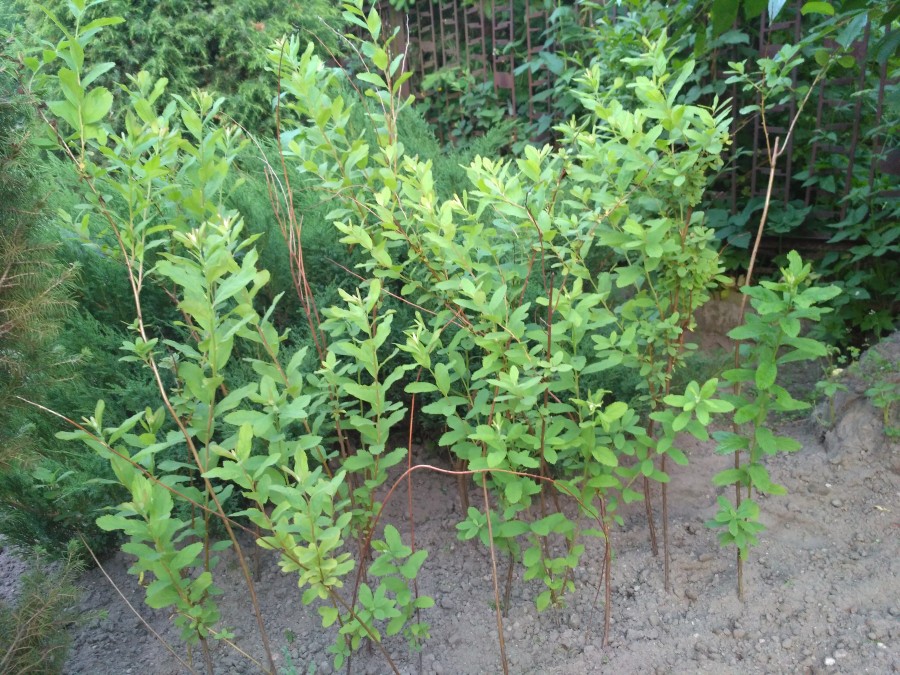
A seedling planted in open ground, as a rule, takes root quickly and easily adapts to new conditions
When planting two or more bushes, the distance between the holes should be 40-50 cm.
Care features
The plant is unpretentious, it is easy to care for it. Spirea Billard is not afraid of frost and drought.
Watering
Billard's spirea needs to be watered as the topsoil dries. It is advisable to cover the trunk circle with hay, straw or peat. Mulch inhibits weed growth and retains moisture. In the late evening, you can spray the bushes with a spray bottle. If you carry out the procedure during the day, burns may appear on the plant.
Top dressing
A young plant needs to acquire a healthy green mass, so it especially needs nutrients. The best option for feeding in the first year is an infusion of mullein, chicken manure, or other fertilizer with a high nitrogen content. Fertilizer is desirable to apply every month. From the second year, it is enough to feed the shrub with mineral complexes.
Pruning
After 4 years, the shrub is cut off, a crown is formed. Old, weak shoots are removed completely, leaving hemp. The procedure is best done in the spring before the leaves appear. The hybrid tolerates haircuts well, therefore it is often used as hedges.
Reproduction methods
Spirea is propagated by dividing the bush, cuttings or layering.
Dividing the bush
The procedure is carried out in the fall. The order of its implementation is as follows:
- It is necessary to dig up the ground around the plant along the diameter of the crown, get the bush out of the ground.
- The roots should be rinsed with running water and allowed to dry.
- With pruning shears, you need to carefully divide the bush into 2-3 parts with healthy roots and at least 2 strong shoots. The tool must be sharp and must be disinfected before starting work.
- Too long roots must be shortened, the sections must be treated with activated carbon powder.
- Next, you should plant the separated parts of the plant in a permanent place.
Layers
In the spring, strong lignified branches of the spirea are pressed to the ground and fixed. Sprinkle and watered the middle of the branch. In the spring, the rooted shoots are chopped off and planted.
Cuttings
In the middle of summer, strong stems are cut from the spirea, they are divided into cuttings of 10 cm each.Each part should have at least 5 leaves. Cuttings are treated with a biostimulant, placed in a box with a nutrient mixture. For the winter, the containers are taken out to the garden bed, sprinkled and covered. In the spring, rooted cuttings are transplanted to the designated place.
Transfer
Do not disturb the spirea unless absolutely necessary. Only adult bushes can be transplanted. The procedure is best done in the fall, when the leaves begin to change color. The cut plant must be dug out with a lump of earth, transplanted into a planting hole, and watered abundantly.
Diseases and pests
Spireas rarely suffer from diseases and insect attacks. Problems arise with inadequate care.
The greatest danger to the plant is the spider mite. The insect can spread throughout the plant and move to neighboring ones. Therefore, it is necessary to deal with the pest immediately after its detection. If a cobweb appears under the leaves, they turn yellow and fall off prematurely, so the plant must be sprayed with a fungicide. Brown and red spots signal the development of the disease.
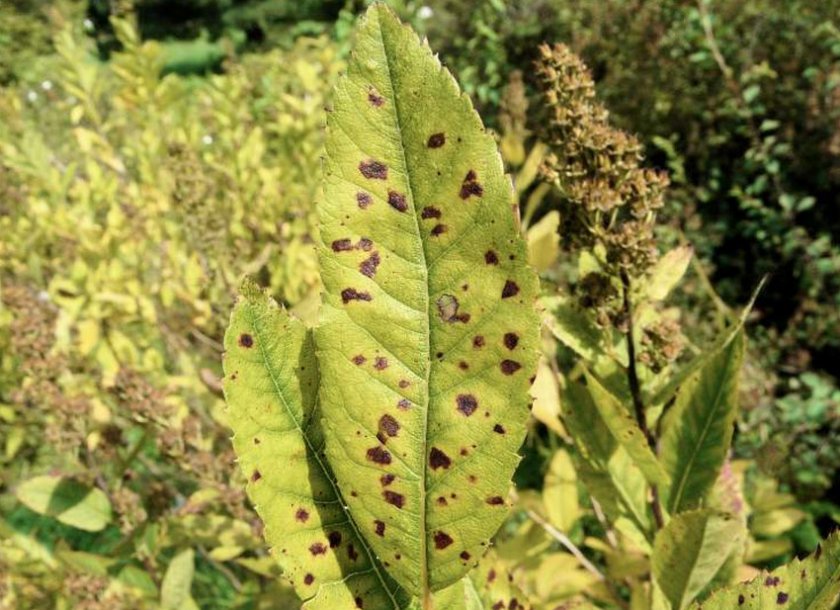
When infected with spotting, the affected areas are removed, and the bush is treated with preparations containing copper
Flowering period
Spirea blooms from July to October. The pink inflorescences are in the shape of candles, the average length of which is 20 cm.
Preparing for winter
Despite the winter hardiness, it is better to cover the shrub. For this purpose, pine spruce branches, white polypropylene bags, agrofibre are suitable. So the plant will be protected from temperature extremes, freezing of young shoots.
Application in landscape design
The shrub gets along well with the vast majority of horticultural crops, so it is often used to decorate plots. The shrub is combined with conifers, lilacs, honeysuckle, viburnum. The plant will decorate the alpine slide and revive the rocky garden.
Spirea painlessly tolerates pruning, without limiting the gardener's imagination. The shrub looks beautiful both on its own and next to other crops. A hedge of plants with flowers of different shades looks luxurious. The aroma of honey attracts butterflies and other beneficial insects to the garden.
Spirea Billard is a noble, beautiful shrub. To maintain its shape and maintain it in good condition, it is important to follow the rules of care. It is necessary to ensure timely watering, and monitor the condition of the soil. Special attention should be paid to disease prevention.
